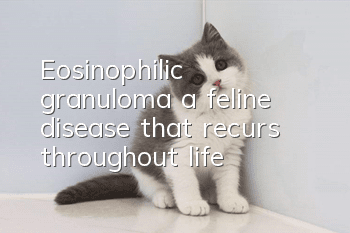Eosinophilic granuloma, a feline disease that recurs throughout life

When there are a large number of eosinophils in the granulation tissue, we call it eosinophilic granuloma.
Eosinophilic granuloma can be divided into the following three categories based on clinical symptoms:
Eosinophilic plaques: It is an allergic reaction that most commonly occurs due to allergic reactions caused by insect bites. Other allergies such as food allergies and environmental allergies are less common.
Lesions (that is, allergic areas) appear as well-defined raised hairless areas or ulcers, usually on the ventral side of the abdomen and inner thighs.
The lesion will be very itchy and the cat will keep licking it, so the lesion will be wet. Severe oral eosinophilic plaques often cause dysphagia, halitosis, and anorexia.
Painless ulcers: may be related to allergies and genes. In rare cases, they may evolve into squamous cell carcinoma.
The lesion has clear boundaries and is located on the upper lip. Sometimes it occurs unilaterally, sometimes it occurs on both sides. The lesions appear as moist ulcers with a crater-like appearance.
Linear granuloma: It is located on the back of the thigh and presents as a clearly demarcated, hairless, string-like tissue bulge. It may also occur on the cat's foot pads, throat, and tongue. Some cats may have swelling of the lower lip or chin. Valgus (also known as fat chin).
Usually it may also be complicated by peripheral lymphadenopathy, causing varying degrees of itching.
Diagnosis:
Press cytology examination
If the lesion appears ulcerated or has exudate, the lesion should be cleaned with normal saline to prevent secondary infected cells from being detected by pressing. Press the slide directly on the lesion, dry it and then stain it. You can see that the inflammatory cells are mainly eosinophils.
Tissue sections
Any suspected mass should first undergo tissue biopsy sampling and biopsy for confirmation.
It is recommended that the following treatments can be taken:
Eliminate the cause: Eliminate allergens such as fleas, mosquitoes, and food.
Steroids: The drugs most commonly used to treat eosinophilic granuloma.
Oral prednisolone can usually control the lesions.
Cyclosporine: used when corticosteroids are ineffective
Most cases can achieve good treatment results, but the disease is likely to relapse and requires repeated treatment
- Why is the cat lying on the ground in pain after eating salted fish?
- When your cat starts peeing and peeing, it may be caused by these problems
- What are the stress reactions of cats in a new environment?
- Why does a cat have bad breath and won't eat?
- Why did the cat vomit some bugs? The cat may be infected with roundworms
- How to raise an Oriental shorthair cat? What are the dietary precautions for an Oriental shorthair cat?
- How to care for cats during childbirth
- Characteristics of British Shorthair in Estrus
- Do Garfield female cats need to be neutered?
- Can a cat sleep after eating too much?



